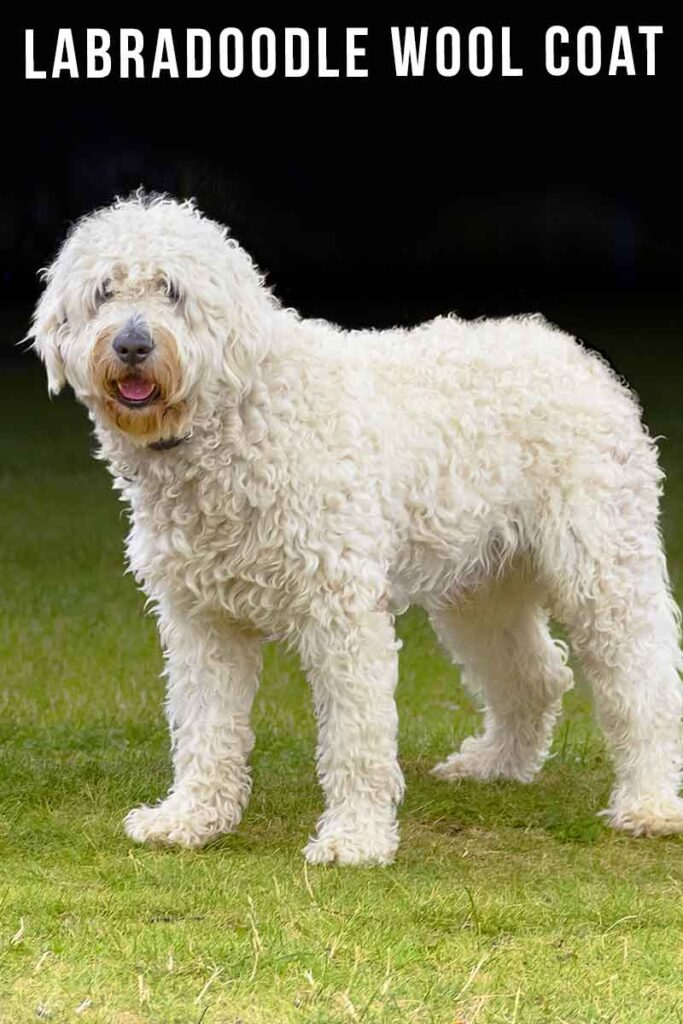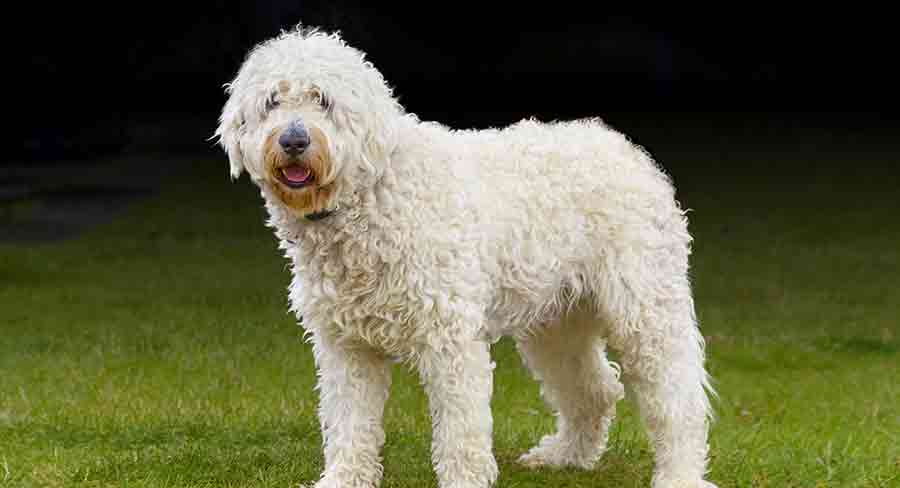The Labradoodle wool coat is one of the more popular coat types, since it is low shedding and potentially the least likely to trigger allergies. Coat type is harder to predict in first generation mixes, so if a breeder is selling wool coat Labradoodles, it’s likely they are a later generation, or have been backcrossed to a purebred Poodle.
A Labradoodle wool coat is the most similar to that of a purebred Poodle. But, even though shedding is less visible, this coat type has high grooming requirements to prevent painful tangles and knots.
What is a Labradoodle Wool Coat?
The wool coat is one of three common coat types for American and Australian Labradoodles. Other coat types are fleece and hair. A Labradoodle wool coat will be much curlier than the other two types. At a glance, it will look just like a Poodle coat! And, this coat type is what has made Poodles such a popular dog in the crossbreeding world.
The term “wool coat” simply refers to the texture of the fur. A Labradoodle with a wool coat can still have longer or shorter fur depending on whether or not an owner chooses to let it grow out or to keep it clipped short. This coat type can also come in the same variety of colors as any other coat type. So, you can expect plenty of variation from one wool Labradoodle to the next!
How Do Labradoodles Get Wool Coats?
Like every other trait, your Labradoodle’s coat type will be determined by their genetics. First generation mixes (f1 Labradoodles) are much harder to predict, as they can inherit any traits from their two very different parents! So, some f1 Labradoodles may have fur like their Labrador parent, some may be like their Poodle parent, and others will fall somewhere in the middle. This means it’s much harder to get first generation mix puppies with a wool coat. Or at least it’s harder to predict. Instead, many breeders will achieve this coat type in subsequent generations, or even in Labradoodles that have been backcrossed to a purebred Poodle.

Will My Labradoodle Puppy Have a Wool Coat?
Labradoodle puppy coats can be very different to their adult coats. All Doodle puppies will have a soft, single-layered coat. Over time, this will shed out to reveal their adult coat. And this applies to all three Labradoodle coat types. So, you can see why it’s hard to predict exactly what coat type a Labradoodle will have when they’re still young!
It’s possible to find breeders that specialize in wool coat Labradoodles. Some will even do genetic testing to see if their puppies have the genes for a curly wool coat. And, some very experienced breeders may even be able to tell a Labradoodle puppy’s adult coat by sight, even in the early months. More often than not, these breeders will work with later generation mixes, or with Doodles backcrossed to Poodles, for a higher chance of inheriting the Poodle coat.
Do Wool Coat Labradoodles Shed?
Like all dogs, wool coat Labradoodles will shed. Don’t worry, you haven’t been conned! Even purebred Poodles shed. However, you likely won’t notice shed fur. Wool coat Labradoodles will shed in small amounts, and the majority of the hairs will be trapped in their curly coat. This is why grooming is so important, as these shedding hairs can cause painful knots and tangles in your dog’s curls.
Compared to fleece and hair coat types, the wool coat Labradoodle will shed the least. And, if you maintain regular grooming sessions, you’ll likely experience no problems related to this shedding fur.
Are Wool Coat Labradoodles Hypoallergenic?
The Labradoodle has long been marketed as a hypoallergenic breed. However, the truth is that there is no hypoallergenic dog breed. All dogs have the proteins that can trigger allergy symptoms. These proteins can be found in canine dander, urine, saliva, and so on. Like it catches shedding hair, your Labradoodles wool coat will also catch any shedding dander. So, there is a lower chance of a wool coat Labradoodle setting off your allergies.
However, it’s important to bear in mind that other things may trigger your allergies, such as saliva-covered dog toys, or even your dog licking your face. Studies have shown a high level of variation to allergy-triggering proteins in dog saliva. So, one Labradoodle may not trigger you, whilst another with the same coat type might. On top of this, wool coats are very high-maintenance. So, you will need to spend a lot of time grooming them, and getting up close to the trapped dander.
Of course, there are ways around this. If there’s someone else at home with you, the grooming responsibilities can fall to them! Or, you could take them to a professional groomer much more frequently than other owners might need to. A good cleaning regime is also essential. So, regularly wash your Doodle’s bedding and any soft toys. Although wool coat Labradoodles can still trigger allergies for some people, with a good cleaning regime and grooming plan in place, many people find that allergies aren’t a problem for them.
How to Groom a Labradoodle with a Wool Coat
We’ve spoken a lot about the high grooming needs of wool coat Labradoodles. But what grooming do they actually need? Well, a wool coat Labradoodle will need the same grooming as a purebred Poodle, since they have the same tight curls. Many owners will choose to clip their Doodle’s coat short at the groomers. This will make daily maintenance a little easier, but isn’t a necessity!
Many owners will use a combination of a slicker brush and a bristle brush. With the slicker brush, they will gently go through their dog’s entire coat to remove any knots and tangles. Then, any loose fur can be removed with the bristle brush. Others may prefer to use a comb, especially when detangling any particularly troublesome knots. However, this can take a little longer than using a slicker brush. Particularly one designed for Poodle fur.
Make sure your Labradoodle is familiar and comfortable with the grooming process from a young age. If you make it a fun and rewarding experience whilst they’re still young, daily grooming as an adult will be much easier and more enjoyable for you both!
Labradoodle Fleece Coat vs Wool Coat
If allergies aren’t an issue for you, you may also want to consider the fleece coat Labradoodle. Labradoodles with a fleece coat have looser curls than wool coat Labradoodles. Fleece coat types are often described as having the same texture and softness as angora wool, which is very appealing to lots of owners!
Fleece coats have lower grooming needs than wool coats, however, it’s likely that this coat type will also shed a lot more visibly, since the coat won’t catch falling hair in the same way. Of course, going to the groomers and clipping it shorter is still an option for the fleece coat. This coat type still requires some level of grooming, but it will be less than the wool coat. So, if you don’t love the idea of spending lots of time every single day grooming your dog’s coat, a fleece coat may be more appealing.
Is a Wool Coat Labradoodle Right for Me?
If you have plenty of time to dedicate to grooming your dog every single day, the wool coat Labradoodle will suit you. Grooming can be a great opportunity to bond with your dog, and since Labradoodles love spending time with their owners, they’ll likely enjoy the experience as much as you! Just ensure you invest in the right tools. If you need more help with grooming your wool coat Labradoodle, speak to a professional groomer! They’ll be happy to show you some great methods, tools, and tips.
If you suffer from allergies, it’s still a good idea to spend some time with the Labradoodle you want to bring home before committing. Some owners with allergies find that wool coat Doodles don’t trigger their symptoms. But, others can still suffer, especially when they have to get up close for grooming. No dog breed is entirely hypoallergenic, but for many people the wool coat Labradoodle sure does come close!
Do You Have a Wool Coat Labradoodle?
Have you already got a wool coat Labradoodle at home, or are you still trying to choose between a wool and fleece coat? We would love to hear your experiences with this coat type in the comments. Do you have any grooming tips for new owners?
Readers Also Liked
References and Resources
- Ali, M. (et al), ‘Genetic Analysis of the Modern Australian Labradoodle Dog Breed Reveals an Excess of the Poodle Genome’, Plos Genetics (2020)
- Vredegoor, D. (et al), ‘Can F 1 Levels in Hair and Homes of Different Dog Breeds: Lack of Evidence to Describe Any Dog Breed as Hypoallergenic’, Journal of Allergy and Clinical Immunology (2012)
- Butt, A. (et al), ‘Do Hypoallergenic Dogs and Cats Exist?’, Annals of Allergy, Asthma and Immunology (2012)
- Miller, R. ‘Differentiation of the Can F 1 Allergen in Hypoallergenic Dog Saliva Compared to Shedding Dog Saliva’, Murray State’s Digital Commons (2021)

